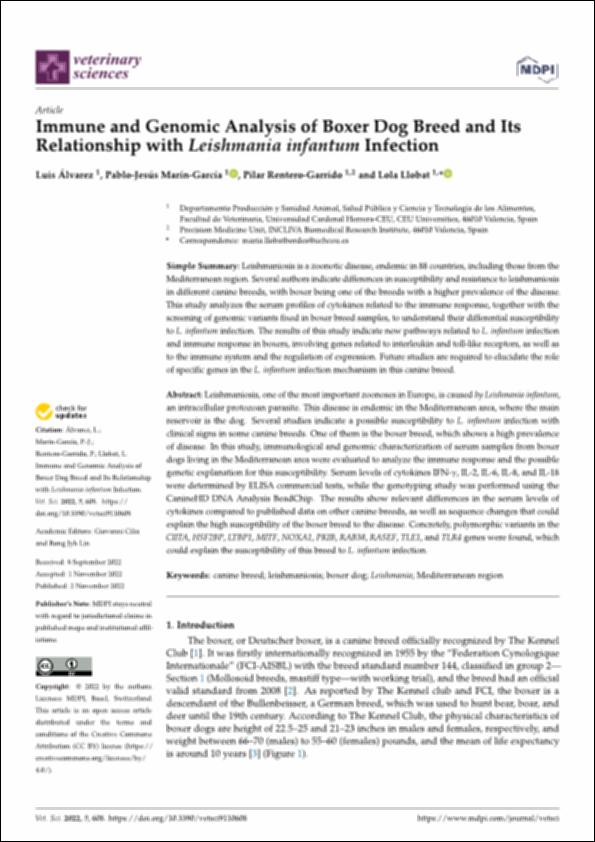Please use this identifier to cite or link to this item:
http://hdl.handle.net/10637/14178Immune and genomic analysis of Boxer dog breed and its relationship with "Leishmania infantum" infection
| Title: | Immune and genomic analysis of Boxer dog breed and its relationship with "Leishmania infantum" infection |
| Authors : | Álvarez Fernández, Luis Marín García, Pablo Jesús Rentero Garrido, Pilar Llobat Bordes, Lola |
| Keywords: | Dogs - Communicable diseases.; Leishmaniasis in dogs.; Leishmaniasis en los perros.; Perros - Enfermedades infecciosas. |
| Publisher: | MDPI |
| Citation: | Álvarez, L., Marín-García, P. J., Rentero-Garrido, P. & Llobat, L. (2022). Immune and genomic analysis of Boxer dog breed and Its relationship with "Leishmania infantum" infection. Veterinary Sciences, vol. 9, i. 11 (02 nov.), art. 608. DOI: https://doi.org/10.3390/vetsci9110608 |
| Abstract: | Leishmaniosis, one of themost important zoonoses in Europe, is caused by Leishmania infantum, an intracellular protozoan parasite. This disease is endemic in theMediterranean area, where the main reservoir is the dog. Several studies indicate a possible susceptibility to L. infantum infection with clinical signs in some canine breeds. One of them is the boxer breed, which shows a high prevalence of disease. In this study, immunological and genomic characterization of serum samples from boxer dogs living in theMediterranean area were evaluated to analyze the immune response and the possible genetic explanation for this susceptibility. Serum levels of cytokines IFN- , IL-2, IL-6, IL-8, and IL-18 were determined by ELISA commercial tests, while the genotyping study was performed using the CanineHD DNA Analysis BeadChip. The results show relevant differences in the serum levels of cytokines compared to published data on other canine breeds, as well as sequence changes that could explain the high susceptibility of the boxer breed to the disease. Concretely, polymorphic variants in the CIITA, HSF2BP, LTBP1,MITF, NOXA1, PKIB, RAB38, RASEF, TLE1, and TLR4 genes were found, which could explain the susceptibility of this breed to L. infantum infection. |
| Description: | Este artículo se encuentra disponible en la siguiente URL: https://www.mdpi.com/2306-7381/9/11/608 Este artículo pertenece al número especial "Parasitology Research: Surveillance Pathogens and Its Mechanism". |
| URI: | http://hdl.handle.net/10637/14178 |
| Rights : | http://creativecommons.org/licenses/by/4.0/deed.es |
| ISSN: | 2306-7381 (Electrónico) |
| Language: | es |
| Issue Date: | 2-Nov-2022 |
| Center : | Universidad Cardenal Herrera-CEU |
| Appears in Collections: | Dpto. Producción y Sanidad Animal, Salud Pública Veterinaria y Ciencia y Tecnología de los Alimentos |
Items in DSpace are protected by copyright, with all rights reserved, unless otherwise indicated.


